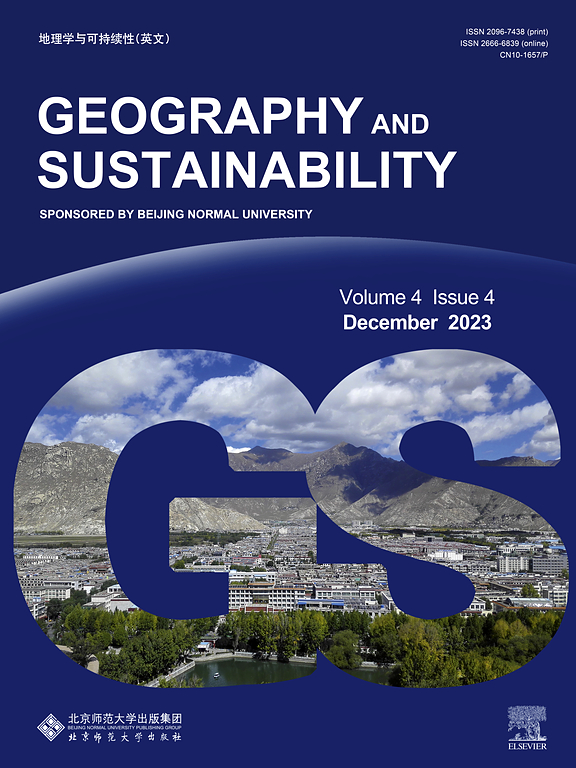Assessment of Chinese urban land-use efficiency (SDG11.3.1) utilizing high-precision urban built-up area data
IF 8
1区 环境科学与生态学
Q1 GEOGRAPHY, PHYSICAL
引用次数: 0
Abstract
Assessment of SDG11.3.1 indicator of the United Nations Sustainable Development Goals (SDGs) is a valuable tool for policymakers in urban planning. This study aims to enhance the accuracy of the SDG11.3.1 evaluation and explore the impact of varying precision levels in urban built-up area on the indicator’s assessment outcomes. We developed an algorithm to generate accurate urban built-up area data products based on China’s Geographical Condition Monitoring data with a 2 m resolution. The study evaluates urban land-use efficiency in China from 2015 to 2020 across different geographical units using both the research product and data derived from other studies utilizing medium and low-resolution imagery. The results indicate: (1) A significant improvement in the accuracy of our urban built-up area data, with the SDG11.3.1 evaluation results demonstrating a more precise reflection of spatiotemporal characteristics. The indicator shows a positive correlation with the accuracy level of the built-up area data; (2) From 2015 to 2020, Chinese prefecture-level cities have undergone faster urbanization in terms of land expansion relative to population growth, leading to less optimal land resource utilization. Only in extra-large cities does urban population growth show a relatively balanced pattern. However, urban population growth in other regions and cities of various sizes lags behind land urbanization. Notably, Northeast China and small to medium cities encounter significant challenges in urban population growth. The comprehensive framework developed for evaluating SDG11.3.1 with high-precision urban built-up area data can be adapted to different national regions, yielding more accurate SDG11.3.1 outcomes. Our urban area and built-up area data products provide crucial inputs for calculating at least four indicators related to SDG11.

基于高精度城市建成区数据的中国城市土地利用效率评价(SDG11.3.1
对联合国可持续发展目标(sdg) SDG11.3.1指标的评估是城市规划政策制定者的宝贵工具。本研究旨在提高SDG11.3.1评价的准确性,探讨城市建成区不同精度水平对指标评价结果的影响。我们开发了一种基于中国地理条件监测数据的2米分辨率的精确城市建成区数据产品算法。本研究利用研究成果和其他研究的数据,利用中低分辨率图像,对2015 - 2020年中国不同地理单元的城市土地利用效率进行了评估。结果表明:①我国城市建成区数据精度显著提高,SDG11.3.1评价结果更准确地反映了城市建成区的时空特征;该指标与建成区数据精度水平呈正相关;(2) 2015 - 2020年,中国地级市土地扩张速度高于人口增长速度,导致土地资源最优利用程度较低。只有在特大城市,城市人口增长才呈现出相对均衡的格局。然而,其他地区和不同规模城市的城市人口增长滞后于土地城市化。值得注意的是,东北地区和中小城市在城市人口增长方面面临重大挑战。利用高精度城市建成区数据评价SDG11.3.1的综合框架可以适应不同的国家区域,得出更准确的SDG11.3.1结果。我们的城市地区和建成区数据产品为计算与可持续发展目标11相关的至少四个指标提供了重要输入。
本文章由计算机程序翻译,如有差异,请以英文原文为准。
求助全文
约1分钟内获得全文
求助全文
来源期刊

Geography and Sustainability
Social Sciences-Geography, Planning and Development
CiteScore
16.70
自引率
3.10%
发文量
32
审稿时长
41 days
期刊介绍:
Geography and Sustainability serves as a central hub for interdisciplinary research and education aimed at promoting sustainable development from an integrated geography perspective. By bridging natural and human sciences, the journal fosters broader analysis and innovative thinking on global and regional sustainability issues.
Geography and Sustainability welcomes original, high-quality research articles, review articles, short communications, technical comments, perspective articles and editorials on the following themes:
Geographical Processes: Interactions with and between water, soil, atmosphere and the biosphere and their spatio-temporal variations;
Human-Environmental Systems: Interactions between humans and the environment, resilience of socio-ecological systems and vulnerability;
Ecosystem Services and Human Wellbeing: Ecosystem structure, processes, services and their linkages with human wellbeing;
Sustainable Development: Theory, practice and critical challenges in sustainable development.
 求助内容:
求助内容: 应助结果提醒方式:
应助结果提醒方式:


